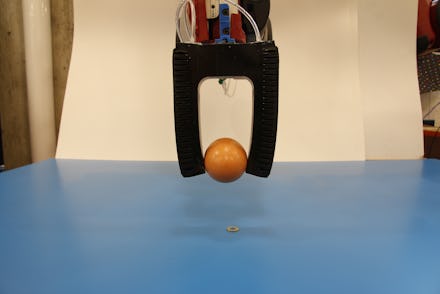These Disposable, 3-D Printed Robots Are the Revolution We've Been Waiting For

Here's the thing with robots: They're a pain in the ass to make. Unless you have connections with a parts manufacturer or have access to your own machining mill, you're probably sourcing parts from third parties and assembling everything by hand — a process that can take months.
But what if you could 3-D print them? Ostensibly, once we've scaled 3-D printers to a human size, we could print pre-assembled robots, ones that could walk around and function. In a disaster zone, something like this would be preferable to sending people out into hazardous conditions.
We're not there yet, but we're starting small. A team of researchers at MIT's Computer Science and Artificial Intelligence Laboratory just published their technique on simultaneously printing both rigid and soft materials in hydraulic robotic parts.
This means you'll be able to print out almost fully functional robots, like this cute hexapod:
Or flexible parts like this soft gripper, straight from your multi-material 3-D printer.
In the paper, which will be presented at the IEEE International Conference on Robotics and Automation, the researchers described three uses for the method: printing out a walking hexapod bot and a soft gripper, both pictured above; and a gear pump, which is a common pump for viscous fluids: think along the lines of oil for automobiles and chemistry lab equipment.
The technique can theoretically be used to print any hydraulic-fluid-powered part. As with any 3-D printing project, the constraint is the size of the printer's workspace. We've seen soft 3-D-printed exoskeletons, and now, we've got pre-assembled robots.
What can we do with this? If you're thinking about soft, flexible robots, the possibilities are endless. While the researchers didn't have any particular application in mind, they did say that it speeds up an otherwise arduous process in building machines: getting the actual thing made.
Read more: Engineers Have Created the Future of Liquid Robots
When making robots is faster and easier, we'll think about them differently. "If robots are no longer handmade, they might be thought of as single-use or disposable," Robert MacCurdy, one of the paper's co-authors, told Mic. "It's pure speculation what this could lead to, but perhaps using them in hazardous locations (disasters) would be more appealing if the loss of the robot is not a concern."
It might be wishful thinking if you're expecting to print the rescue robots that won the DARPA competition last summer, but the idea is there: We can now jump straight into making pre-assembled robots without the process being a huge time and money sink.
3-D printing also lets engineers make easy changes to their designs. "Now, changing the robot to accommodate some new environmental condition (like a stair that's too tall to climb) can be done in a matter of hours or days, rather than weeks or months," MacCurdy said.
While the team had to modify the liquid-casting part of printer head to make it work reliably, it's still far less complicated than sourcing and assembling hydraulic parts the traditional way. The hexapod robot pictured above took 22 hours to print on their 5-year-old multi-material printer, which might be a lifetime if you've never 3-D printed before. But for people who spend their lives making these machines, it's a huge step forward.